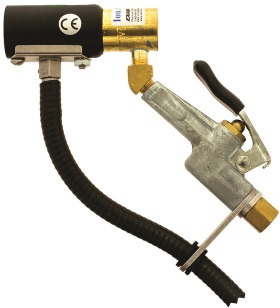A customer contacted EXAIR to find a better way to cool a die in a rotational molding facility. Rotational molding, or Rotomolding, involves a heated hollow mold which is filled with plastic material. It is then slowly rotated (usually around two perpendicular axes), causing the softened material to disperse and cling to the walls of the mold. In order to maintain an even thickness throughout the part, the mold has to continue to rotate during the heating phase. After the desired timing sequence, the heating is turned off to allow the material to harden.
This particular company was making plastic containers. To try and improve the cycle rate between each container, they were using two fans (reference photo below) for cooling. Time is money in this industry, and they wanted to target the fans to improve cooling. They mentioned that water jackets for cooling would affect the life of the molds due to thermal shock. So, they needed to cool with air; and EXAIR had a solution for them; the Super Air Amplifiers.I also recommended to add one piece of a model 120022 2” Super Air Amplifier for cooling the inside of the mold. Because the opening in the center of the mold is relatively small, a fan would take up most of the area. Thus, not allowing the hot air to escape. Since the 2” Super Air Amplifier is much smaller, they were able to place the air stream in the center allowing the hot air to escape around the edge of the hole. With this combination, we were able to cool the mold 25% faster than the fans.
To expand on the comparison, EXAIR Super Air Amplifiers and electrical fans are designed to move air. Fans use motors and blades to push the air toward the target. There are mainly two types, centrifugal fans and axial fans. The customer above was using axial fans. The air enters from directly behind the fan, and the blades “slap” the air forward to the target. This creates a turbulent and loud air noise. The EXAIR Super Air Amplifiers does not use any blades or motors to push the air. They use a Coanda profile with a patented shim to create a low pressure to draw the air.So, they create laminar air flow which is much quieter.
In physics, it is easier to pull than it is to push. The same goes for moving air. Fans are designed to “push” the air and the Super Air Amplifiers are designed to “pull” the air. This method of pulling makes it simple to create a laminar flow in a small package which is more efficient, effective, and quiet. With the patented shims inside the Super Air Amplifiers, they maximize the amplification by “pulling” in large amounts of ambient air while using less compressed air. More air means better cooling. If you want to move away from blower systems or axial fan systems to get better cooling, drying, cleaning, and conveying; you can contact an Application Engineer for more details about our Super Air Amplifiers.
Vivek Engineers #22, 1st Floor, 1st Cross, Adj. to IIMB Compound, Bilekahalli Indl. Area, Bannerghatta Road, Bangalore - 560 076 Ph : 080 - 2648 1309, 4170 1145. Mob : | |||||
















